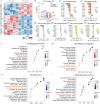This is a preprint.
Gene therapies alleviate absence epilepsy associated with Scn2a deficiency in DBA/2J mice
- PMID: 40501831
- PMCID: PMC12157391
- DOI: 10.1101/2025.06.03.657652
Gene therapies alleviate absence epilepsy associated with Scn2a deficiency in DBA/2J mice
Abstract
Mutations in the voltage-gated sodium channel gene SCN2A, which encodes the NaV1.2 channel, cause severe epileptic seizures. Patients with SCN2A loss-of-function (LoF) mutations, such as protein-truncating mutations, often experience later-onset and drug-resistant epilepsy, highlighting an urgent unmet clinical need for new therapies. We previously developed a gene-trap Scn2a (Scn2a gt/gt ) mouse model with a global NaV1.2 reduction in the widely used C57BL/6N (B6) strain. Although these mice display multiple behavioral abnormalities, EEG recordings indicated only mild epileptiform discharges, possibly attributable to the seizure-resistant characteristics associated with the B6 strain. To enhance the epileptic phenotype, we derived congenic Scn2a gt/gt mice in the seizure-susceptible DBA/2J (D2J) strain. Notably, we found that these mice exhibit prominent spontaneous absence seizures, marked by both short and long spike-wave discharges (SWDs). Restoring NaV1.2 expression in adult mice substantially reduced their SWDs, suggesting the possibility of SCN2A gene replacement therapy during adulthood. RNA sequencing revealed significant alterations in gene expression in the Scn2a gt/gt mice, in particular a broad downregulation of voltage-gated potassium channel (KV) genes, including KV1.1. The reduction of KV1.1 expression was further validated in human cerebral organoids with SCN2A deficiency, highlighting KV1.1 as a promising therapeutic target for refractory seizures associated with SCN2A dysfunction. Importantly, delivery of exogenous human KV1.1 expression via adeno-associated virus (AAV) in D2J Scn2a gt/gt mice substantially reduced absence seizures. Together, these findings underscore the influence of mouse strain on seizure severity and highlight the potential of targeted gene therapies for treating SCN2A deficiency-related epilepsies.
Keywords: KV1.1; NaV1.2; SCN2A; absence seizure; gene therapy; human brain organoid; mouse strain difference; voltage-gated sodium channel.
Conflict of interest statement
Conflict of interests: The authors have declared that no conflict of interest exists.
Figures






Similar articles
-
Human iPSC-derived microglia sense and dampen hyperexcitability of cortical neurons carrying the epilepsy-associated SCN2A-L1342P mutation.J Neurosci. 2024 Nov 18;45(3):e2027232024. doi: 10.1523/JNEUROSCI.2027-23.2024. Online ahead of print. J Neurosci. 2024. PMID: 39557580 Free PMC article.
-
Prognosis of adults and children following a first unprovoked seizure.Cochrane Database Syst Rev. 2023 Jan 23;1(1):CD013847. doi: 10.1002/14651858.CD013847.pub2. Cochrane Database Syst Rev. 2023. PMID: 36688481 Free PMC article.
-
Carbamazepine versus phenytoin monotherapy for epilepsy: an individual participant data review.Cochrane Database Syst Rev. 2017 Feb 27;2(2):CD001911. doi: 10.1002/14651858.CD001911.pub3. Cochrane Database Syst Rev. 2017. Update in: Cochrane Database Syst Rev. 2019 Jul 18;7:CD001911. doi: 10.1002/14651858.CD001911.pub4. PMID: 28240353 Free PMC article. Updated.
-
Carbamazepine versus phenobarbitone monotherapy for epilepsy: an individual participant data review.Cochrane Database Syst Rev. 2016 Dec 15;12(12):CD001904. doi: 10.1002/14651858.CD001904.pub3. Cochrane Database Syst Rev. 2016. Update in: Cochrane Database Syst Rev. 2018 Oct 24;10:CD001904. doi: 10.1002/14651858.CD001904.pub4. PMID: 27976799 Free PMC article. Updated.
-
Rufinamide add-on therapy for refractory epilepsy.Cochrane Database Syst Rev. 2018 Apr 25;4(4):CD011772. doi: 10.1002/14651858.CD011772.pub2. Cochrane Database Syst Rev. 2018. Update in: Cochrane Database Syst Rev. 2020 Nov 8;11:CD011772. doi: 10.1002/14651858.CD011772.pub3. PMID: 29691835 Free PMC article. Updated.
References
-
- Hildebrand MS, Dahl HHM, Damiano JA, Smith RJH, Scheffer IE, and Berkovic SF. Recent advances in the molecular genetics of epilepsy. Journal of Medical Genetics. 2013;50(5):271–9. - PubMed
-
- Heyne HO, Artomov M, Battke F, Bianchini C, Smith DR, Liebmann N, et al. Targeted gene sequencing in 6994 individuals with neurodevelopmental disorder with epilepsy. Genet Med. 2019;21(11):2496–503. - PubMed
Publication types
Grants and funding
LinkOut - more resources
Full Text Sources
Miscellaneous
